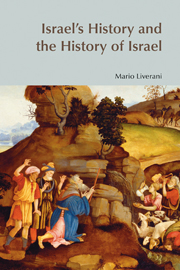Book contents
- Frontmatter
- Dedication
- Contents
- List of Tables and Illustrations
- Foreword
- Abbreviations
- IMPRINTING
- Part I A NORMAL HISTORY
- Chapter 2 THE TRANSITION (TWELFTH CENTURY)
- Chapter 3 THE NEW SOCIETY (c. 1150–1050)
- Chapter 4 THE FORMATIVE PROCESS (c. 1050–930)
- Chapter 5 THE KINGDOM OF ISRAEL (c. 930–740)
- Chapter 6 THE KINGDOM OF JUDAH (c. 930–720)
- Chapter 7 THE IMPACT OF THE ASSYRIAN EMPIRE (c. 740–640)
- Chapter 8 PAUSE BETWEEN TWO EMPIRES (c. 640–610)
- Chapter 9 THE IMPACT OF THE BABYLONIAN EMPIRE (c. 610–585)
- INTERMEZZO
- Part II AN INVENTED HISTORY
- EPILOGUE
- Bibliography
- Index of References
- Index of Names of Persons and Deities
- Index of Placenames
Chapter 5 - THE KINGDOM OF ISRAEL (c. 930–740)
from Part I - A NORMAL HISTORY
- Frontmatter
- Dedication
- Contents
- List of Tables and Illustrations
- Foreword
- Abbreviations
- IMPRINTING
- Part I A NORMAL HISTORY
- Chapter 2 THE TRANSITION (TWELFTH CENTURY)
- Chapter 3 THE NEW SOCIETY (c. 1150–1050)
- Chapter 4 THE FORMATIVE PROCESS (c. 1050–930)
- Chapter 5 THE KINGDOM OF ISRAEL (c. 930–740)
- Chapter 6 THE KINGDOM OF JUDAH (c. 930–720)
- Chapter 7 THE IMPACT OF THE ASSYRIAN EMPIRE (c. 740–640)
- Chapter 8 PAUSE BETWEEN TWO EMPIRES (c. 640–610)
- Chapter 9 THE IMPACT OF THE BABYLONIAN EMPIRE (c. 610–585)
- INTERMEZZO
- Part II AN INVENTED HISTORY
- EPILOGUE
- Bibliography
- Index of References
- Index of Names of Persons and Deities
- Index of Placenames
Summary
Uncertain Beginnings and Consolidation
After Solomon's death, the biblical account places a ‘schism’ of the tribes of Israel from the ‘house of David’ that took place in an assembly in Shechem. Here, as a result of excess taxation, the rule of Solomon's heir, Rehoboam was rejected, and Jeroboam (formerly the official in Jerusalem in charge of the corvée) was elected king. This story serves to link the presumed Davidic-Solomonic ‘United Kingdom’ to the later reality of the permanent separation of two centres of political power in Jerusalem and Shechem. It is narrated in a colourful way, with the dialogue between king and population underscoring the opposition between tribal allegiance and royal oppression:
‘My father made your yoke heavy, but I will add to your yoke; my father disciplined you with whips, but I will discipline you with scorpions’…
“What share do we have in David? We have no inheritance in the son of Jesse. To your tents, O Israel! Look now to your own house, O David'
(1 Kgs 12.14, 16).What probably happened is that the tribe of Benjamin strengthened its ties with Jerusalem, a city on its borders, and with Judah; on the other side Ephraim joined together Manasseh, forming a privileged relationship that was expressed and emphasized in the tribal genealogies by providing them with a common offspring from Joseph.
- Type
- Chapter
- Information
- Israel's History and the History of Israel , pp. 104 - 127Publisher: Acumen PublishingPrint publication year: 2005



